The Asia-Pacific Journal, Vol. 13, Issue. 37, No. 2, September 14, 2015
Robin O’Day
See footnote 1 in regards to the article title.
SEALDs demonstration, August 23, 20152
As a student movement, SEALDs (Students Emergency Action for Liberal Democracy) is often compared with the ANPO student movements of the 1960s and 1970s by media, outside observers, and the members themselves. The comparison is obvious since SEALDs has been able to politically mobilize large numbers of youth to a degree so far unseen since the AMPO period, and both movements are concerned, at least in part, with security treaties with the United States and Japan’s global role. Yet, SEALDs is also contrasted with, and works hard to distinguish itself from ANPO in an effort to differentiates itself from this legacy. While it is valuable to compare SEALDs with the student activism of ANPO, it is also import to recognize SEALDs positioning within the broader social movement scene in contemporary Japan.
The freeter movement against precarity that emerged in 2004 (see Cassegard 2014 for a genealogy of recent youth movements in Japan; see O’Day 2012 for a close ethnography of its political organization and movements) also provides a productive comparison since freeter youth activists also tried to break free from the stigma against public protest and youth activism left over from the ANPO period. Two notable examples of the freeter movement are the General Freeter Union (Furītā Zenpan Rōdō Kumiai), known for organizing their annual alternative “Freedom and Survival May Day,” and the Amateur’s Riot (Shirōto no Ran) organized by a group of activists running recycle shops, cafes, and hangout spaces near Koenji station and known for organizing a series of alternative protest events (Obinger 2015).
One of the important distinctions between these different youth movements is that the analysis of some freeter activists is compatible with calls for radical change, while SEALDs attempts to restore the general status quo of the pre-Abe period. SEALDs main grievance is that the principles of “liberal democracy” have been violated by the “reinterpretation” (that is, the undermining) of the Constitution and through pushing forward a set of security bills despite substantial popular opposition and doubts about their procedural legitimacy. These are concrete, immediate, and pressing issues that have been picked up even by the mainstream media. By contrast, the freetermovement is calling for a far more radical re-evaluation of the social, political, and economic configuration of Japanese society. The annual Freedom and Survival May Day demonstration, organized by the General Freeter Union, for instance, is ideologically aligned with EuroMayDay, a transnational anti-globalization movement aimed at protesting and protecting the rights of precarious workers. While it is difficult to reduce the range of issues within the freeter movement to a single grievance, there is a close identification in the movement with the “precariat” (see Amamiya 2007 for an activist’s articulation of the idea in Japan). The concept of the precariat, a combination of “precarious” and “proletariat,” suggests that a new social class is emerging in postindustrial economies through a shared economic and social insecurity (Standing 2011). As such, this is a shift that has been probably occurring since the Japanese economy started to slow its growth trajectory, about 1975, and is linked to the labor restructuring policies of both Nakasone (1982-1987) and Koizumi (2001-2006). In short, these are not treated as being localized in an easily identifiable person or single policy, nor are they immediate threats in the same sense—rather they are difficult to understand by academic or popular audiences.
Nonetheless, freeter movement activists have tried to mobilize youth by creating a political opportunity rooted in the limitations they face in the labor market. One of the founding members of TheFreeter Union Fukuoka, Ono Toshihiko, explained to me in 2008 how the group was framing the politics of the freeter movement:
Freeters protest at the “May Day 2008, Freedom and Existence: Precariats Multiply and Connect” (jiyū to seizon no me-de-2008: purekaria-to wa zōsyoku/renketsu), May 3, 2008. Shinjuku, Tokyo, Japan.
…the so-called “precariat,” or the precariousness of many workers these days is influenced by so-called “neoliberal” tendencies. That neoliberalism is the release of the instincts of capitalists or general capital…If I can put it very very simply, that is what neoliberalism looks like. In general we are against that kind of tendency, so in demonstrations and on some other occasions we speak out against that kind of tendency. So one thing that is clear is if someone thinks it is okay for society to go in the direction of neoliberalism or capitalism, such a person cannot be a member of our union.
To oppose neoliberal capitalism, Ono suggests, is at the core of his understanding of the freeter movement. As Ono describes it, freeter movement politics is effectively an oppositional politics by those who feel pushed out of the mainstream by corporate and state interests that prioritize economic growth over individual wellbeing, particularly at the expense of young workers struggling to gain a foothold in the labor market.
In contrast to the freeter movement, SEALDs’ main grievance is more circumscribed. Indeed, their focus on stopping current security legislation has been criticized by some as being too limited. Yet their framing of the issues—“No More War” or “Stop Abe” have narrowed these issues down into powerfully felt and clearly articulated issues that direct action can be identified and taken to address. SEALDs may have a limited focus on stopping current security legislation, but the simplicity of its message appears to be effective. On the other hand, the resistance by Amateur’s Riot, and the General Freeter Union to adopting a unifying platform beyond a loosely defined identification with being a “precariat” for their movements has led to criticism that they lack coherence and focus, making it that much harder to communicate their message. Short of a wholesale redistribution of wealth or revamping of labor regulation—indeed, calling into question the foundations of Japanese postwar capitalism—it is even now somewhat difficult to identify a cause, event or any action that would address the grievance behind the freeter movements. It is not perhaps surprising that it was more difficult for the freeter movements to convince potential supporters of the immanent dangers of participating in irregular employment. The challenge to sufficiently understand, explain, and offer concrete alternatives to neoliberalism also exacerbates the movement’s dilemma in mobilizing new members.
Protestors dressed in cosplay outfits are part of the characteristics of freeter protests. Freedom and Existence May Day protest. May 4, 2009. Miyashita Park, Tokyo, Japan.
The style of demonstrations between SEALDs and the freeter movement is another important point of comparison as both groups seek to differentiate themselves from the image of violence and ideological and political extremism that has become associated with ANPO, albeit in very different ways. Freeter activists developed a protest style through their “sound demos” (see Manabe 2013) that attempted to distinguish their movement from the more militant protests of the traditional left by making them appealing to youth in incorporating music, art, and popular culture into their protest repertoires (Hayashi and McKnight 2005; Mouri 2005). The Freedom and Survival May Days and the different kinds of protests organized by Amateur’s Riot, like their 2005 “Return our bikes,” (Ore no chari o kaese) demonstration against the police crackdown on illegally parked bikes, have been more playfully subversive. Freeter demonstrations like these have a more anarchistic quality—with plenty of pranksters in the mix—thumbing their noses at authority, albeit in a non-violent way. Protesters at the Freedom and Survival May Days express themselves in more clearly subversive ways, for example, through cosplay, cross-dressing, street art performances, music, and dance. The organizers tolerate a wide variety of political positions, and encourage participants to have “fun” in their expressions, leading to some skepticism from both the activist left and the popular media at large about the seriousness of their commitment to their political cause. The uninhibited atmosphere at these events is often met by a far more hostile and suspicious contingent of police in full riot gear than in the case of SEALDs. Japanese police often treat small movements that are seen as operating on the political fringes of Japanese society harshly.
Riot police tightly control the “May Day 2008, Freedom and Existence:Precariats Multiply and Connect” protest May 3, 2008. Tokyo, Japan.
While doing fieldwork at the Freedom and Survival May Day demonstration in 2008, I asked one of the organizers what they were hoping to achieve with their demonstrations. This freeter activist, a member of the General Freeter Union, and one of the organizers of the May Day sound demonstrations responded, “well the point of the demo is to have fun.” As we continued to talk he admitted that he was personally frustrated that the organizers could not agree on making a stronger political statement through the sound demonstration. However, he conceded that “fun” had to be enough of an organizing principle since “…the different people who come feel oppressed. It doesn’t matter where they are, at school, or at the office, or anywhere, they feel oppressed. So they don’t want to feel oppressed when they carry out the demo on the street—they want to feel free.” Sound demos, for the freeter movement, emerged from a space of disempowerment, and marginalization. Although having “fun” at a demonstration may appear to be frivolous, having fun in itself is meant to be a subversive act by momentarily overturning the constraints and limitations felt by young freeters. Furthermore, having fun at a political demonstration—through music, cosplay, or dancing—is also among the ways that the freeter movement seeks to distinguish its politics and protest style from a more militant style of protest by an older generation of activists. Just as the EuroMayDay movement aims to revitalize traditional May Day solidarity celebrations by focusing on the plight of the precariat and infusing protest with a carnivalesque atmosphere, so too are freeteractivists injecting their demonstrations with an atmosphere of playfulness.
Culture and performance are important foci for SEALDs as well, and in part functions in similar ways: to engage a fuller commitment of the individual, of demonstrating that politics is not so separate from the rest of their lives. But it is a different sort of culture and differentially deployed and to different ends. For SEALDs, the cultural coding is not to demonstrate subversiveness but normality, that being involved in politics is neither dark and dangerous, but neither are their members odd and out of step with the mainstream of Japanese society, and in particular, youth culture. One SEALDs member describes how he sees their movement as a departure from previous protest movements when he said:
…we think that social movements before us seemed unapproachable, scary and uncool for young people. I don’t mean to totally disregard all the old social movements that have happened before us, and I know that there have been people who did something meaningful and fought for their causes. However, they were a bit hard for us to identify with, so we are trying to get rid of that scary image. I think it’s an important factor to be fashionable and to use music in order to attract our generation so that we can raise our voice.3


SEALDs demonstration, Shibuya, August 23, 2015
Another SEALDs member also stressed the need to make their movement appealing to “regular” students. She argues that their movement has to be attractive if they hope to persuade college students to care about politics and social issues. She said:
We need to attract regular university students who would otherwise be uninterested in social movements. Until now, it was fine to have social movements only amongst those activists, but now we are in the situation where we need to get people who would not be interested in or care about social issues. I think there are many reasons why previous social movements have failed and disappeared, but I think their way of doing things is just old; not to mention they look uncool…So we needed to refresh the image itself in order to attract regular university students who grew up with new things and are not interested in social issues.
Just as the freeter demos tried to embody their alternative cultural orientation (sometimes called ‘prefigurative’), the SEALDs demonstrations are more tightly controlled and disciplined. They are not singing and dancing in cosplay clothes but have reverted to a call and response style of demos that date back to before the emergence of sound demos in 2004, punctuated by speeches that are designed to unify their participants in auditory and emotional rhythm. SEALDs has established its own design subgroup of core members to shape their visual images online and through the placards at the demos, even to choreograph the demo itself (their posters (see Fig 7)–even Youtube is attractive and professional). They control who can speak at the demonstrations so their message stays on point, and they invite a range of high profile politicians, scholars, and mainstream media to their events to lend legitimacy to their movement without compromising their independence. They have worked hard to keep good relationships with the police, who, while charged with keeping order at their demonstrations, are often funneling everyone who comes out the exit of Kasumigaseki Station to the right places.
Protest Posters at the SEALDs demonstration, August 23, 2015, Shibuya
It is also important to recognize that while these are both youth movements there is an important distinction between the social status and cultural capital of their respective members. Freeter groups are, by definition, focused on organizing marginal youth in Japanese society, those who have fallen off the track (ochikobore) (Slater 2010). The movement culture among freeter activists is differently aligned with marginal peoples like freeters, the working poor, NEETs (Not in Education, Employment, or Training), hikikomori (shut-ins), and other marginal people that do not easily fit into mainstream society. Those involved in the freeter movement are either on the verge of falling outside of mainstream society, or have already done so.
SEALDs members are overwhelmingly from elite, private universities—indeed, this is also part of their whole branding even though they are open to students from any schools, and presumably to those not in college—although non-students must pay more to attend the various club or salon events. They talk openly about getting regular jobs and integrating into mainstream society once they graduate from university, and often worry that their involvement in political activism could jeopardize this professional future.4 This has led to the impression among some that this is a bourgeois movement, a bunch of rich kids playing at politics. Yet, there is another, quite different reading of this group, too.
Many of the SEALDs members fully appreciate their privileged positions in Japanese society, and seek to use some their cultural capital to push their political agenda forward. Their privilege is in fact part of their politics, as they self-consciously use it as a platform from which they feel empowered to speak. One SEALDs member explained it this way:
Sometimes we are criticized because of the fact that we are all university students, but that’s who SEALDs are. We are people who can go to university: who can receive the opportunity to get an education even if we have to borrow money from scholarship programs. I don’t know if we call it the environment we grew up in, but we are from a certain social class so we are not like those contract (haken) workers who are having a hard time making ends meet and lashing out in anger toward the establishment.
Clearly this SEALDs member sees a sharp distinction between a freeter politics, based on frustration with economic inequalities and limited opportunities in the labor market, with the current student movement against stopping the security bills. He continues:
Our actions are backed up with our education, so I think that’s why our movement has become successful and that is a big difference. People sometimes criticize us saying that we are the social class that has not committed to any social movement, and that we should just do something else if we have freedom (yoyu). But we are just different from those types of people who have participated in the old movements—we do have freedom, and we do have an education.
SEALDs is suggesting that students can use some of the freedom that their positioning affords for political engagement, instead of channeling it into more traditional activities like sports clubs and social circles, that tend to dominate students’ leisure time.
Yet, SEALDs is also proposing something more significant than a reallocation of students’ time—they are also attempting to construct a different kind of political identity among college students. Another SEALDs member explained it this way:
Our movement is not our life; it is a part of our life not our whole life. I went to class yesterday as usual, and we have rappers, people who do music, people who just study, people who are trying to be teachers, we have all kinds of people, and our movement is a part of what we do in our life but not our whole life. If you focus on the movement and movement only, you will become narrow.
What this SEALDs member is suggesting is a reconfiguration of what constitutes student political identity. SEALDs is essentially showing other students that it is acceptable to seriously engage political ideas, without become radical, or having to completely devote themselves to the cause. SEALDs is challenging an all-or-nothing orientation to politics that tends to cleave most students into taking either an apolitical stance, or fully committing to a cause that will likely marginalize them. Instead, SEALDs is coming up the middle with a proposition that you can be a regular student, have conventional ambitions, aspire to a middleclass life, and still carve out a piece of yourself that is informed and engaged with political issues. If this proposition is hardly radical, it is currently resonating with a broad spectrum of students.
Robin O’Day is a cultural anthropologist, and currently a Japan Society for the Promotion of Science (JSPS) post-doctoral fellow at the University of Tsukuba. He is an ethnographer who works on labor and youth politics.
Recommended citation: Robin O’Day, “Differentiating SEALDs from Freeters, and Precariats: the politics of youth movements in contemporary Japan”, The Asia-Pacific Journal, Vol. 13, Issue 37, No. 2, September 14, 2015.
Related articles
• David Slater, Robin O’Day, Satsuki Uno, Love Kindstrand and Chiharu Takano, SEALDs (Students Emergency Action for Liberal Democracy): Research Note on Contemporary Youth Politics in Japan
• Scott North, Limited Regular Employment and the Reform of Japan’s Division of Labor
• Noriko Manabe, Music in Japanese Antinuclear Demonstrations: The Evolution of a Contentious Performance Model
• Nicola Liscutin, Indignez-Vous! ‘Fukushima,’ New Media and Anti-Nuclear Activism in Japan
• Sachie Mizohata, The Trans-Pacific Partnership and its Critics: An introduction and a petition
• David H. Slater, The Making of Japan’s New Working Class: “Freeters” and the Progression From Middle School to the Labor Market
• Emilie Guyonnet, Young Japanese Temporary Workers Create Their Own Unions
• Stephanie Assmann and Sebastian Maslow, Dispatched and Displaced: Rethinking Employment and Welfare Protection in Japan
Bibliography
Amamiya, Karin
2007. プレカリアート―デジタル日雇い世代の不安な生き方 (Purekariāto.
Dejitaru hiyatoi sedai no fuan na ikikata) (Precariats: The Unstable Way of Life of the Digital Day Laboring Generation) Tokyo: Yosensha.
Cassegard, Carl.
2014. Youth Movements, Trauma and Alternative Space in Contemporary Japan. Leiden, Boston: Global Oriental.
Hayashi, Sharon & Anne McKnight
2005 Good-bye Kitty, Hello War: The Tactics of Spectacle and New Youth Movements in Urban Japan. Positions, 12(1), 87-113.
Japan Times
2015 “Should SEALDs student activists worry about not getting hired?” by Hifumi Okunuki, August 30.
Manabe, Noriko
2013. “Music in Japanese Antinuclear Demonstrations: The Evolution of a Contentious Performance Model,”The Asia-Pacific Journal, Vol. 11, Issue 42, No. 3, October 21, 2013.
Mouri, Yoshitaka
2005 Culture = Politics: the emergence of new cultural forms of protest in the age of freeter. Inter-Asia Cultural Studies, 6(1), 17-29.
Obinger, Julia
2015 Alternative Lebensstile und Aktivismus in Japan Der Aufstand der Amateure in Tokyo. Springer.
O’Day, Robin
2012 Japanese irregular workers in protest: freeters, precarity and the re-articulation of class. Vancouver, University of British Columbia (Unpublished Dissertation).
Slater, David H.
2010 “The Making of Japan’s New Working Class: “Freeters” and the Progression From Middle School to the Labor Market,” The Asia-Pacific Journal, 1-1-10, January 4th, 2010.
Notes
1 This paper is part of a series of research articles and reports appearing in The Asia-Pacific Journal introducing the SEALDs student movement. The main article can be found here: “Students Emergency Action for Liberal Democracy: Research Note on Contemporary Youth Politics in Japan” by Slater, O’Day, Uno, Kindstrand, and Takano (2015). This paper draws in part on a research project linked to the Faculty of Liberal Arts and the Graduate School of Japanese Studies at Sophia University, and funded by a Kaken B grant from the Japanese Government. Our research team consists of undergraduate, graduate and post-graduate students working together in subproject groups usually over the course of at least a year. Documentary and archival research supports the video interview and ethnographic data that is the core of the project. Data is shared among groups and members with all contributors being able to draw upon the data for collaborative or individual research and writing. The data collected—video interviews, transcripts and translations, etc.—are shared with members of NPOs or social movement groups. In short, the project is open to all. We welcome collaboration from researchers and activists. (dhslater@gmail.com; oday.robin.fw@u.tsukuba.ac.jp)
2 The author took all photographs. Please do not reproduce any of the images without permission.
3 I have deliberately refrained from using the actual names of SEALDs members in this paper because of the potential consequences of identifying them. The names of many of the SEALDs leaders can be found in Japanese media. Nonetheless, youth activists, whether part of the freeter movement, SEALDs, or any other social movement in Japan are vulnerable to possible repercussions in their studies, employment, or in their personal lives. Therefore, our research project attempts to minimize risks to activists, particularly the regular members of SEALDS, by protecting their identities unless using their actual names is necessary.
4 Nor is this an irrational fear, since a Liberal Democratic Party lawmaker in fact threatened SEALDs members that their continued protesting would—and in his opinion, should—destroy any chance of having professional careers (Japan Times 2015).
SEALDs demonstration, August 23, 20152
Freeters protest at the “May Day 2008, Freedom and Existence: Precariats Multiply and Connect” (jiyū to seizon no me-de-2008: purekaria-to wa zōsyoku/renketsu), May 3, 2008. Shinjuku, Tokyo, Japan.
…the so-called “precariat,” or the precariousness of many workers these days is influenced by so-called “neoliberal” tendencies. That neoliberalism is the release of the instincts of capitalists or general capital…If I can put it very very simply, that is what neoliberalism looks like. In general we are against that kind of tendency, so in demonstrations and on some other occasions we speak out against that kind of tendency. So one thing that is clear is if someone thinks it is okay for society to go in the direction of neoliberalism or capitalism, such a person cannot be a member of our union.
Protestors dressed in cosplay outfits are part of the characteristics of freeter protests. Freedom and Existence May Day protest. May 4, 2009. Miyashita Park, Tokyo, Japan.
Riot police tightly control the “May Day 2008, Freedom and Existence:Precariats Multiply and Connect” protest May 3, 2008. Tokyo, Japan.
…we think that social movements before us seemed unapproachable, scary and uncool for young people. I don’t mean to totally disregard all the old social movements that have happened before us, and I know that there have been people who did something meaningful and fought for their causes. However, they were a bit hard for us to identify with, so we are trying to get rid of that scary image. I think it’s an important factor to be fashionable and to use music in order to attract our generation so that we can raise our voice.3
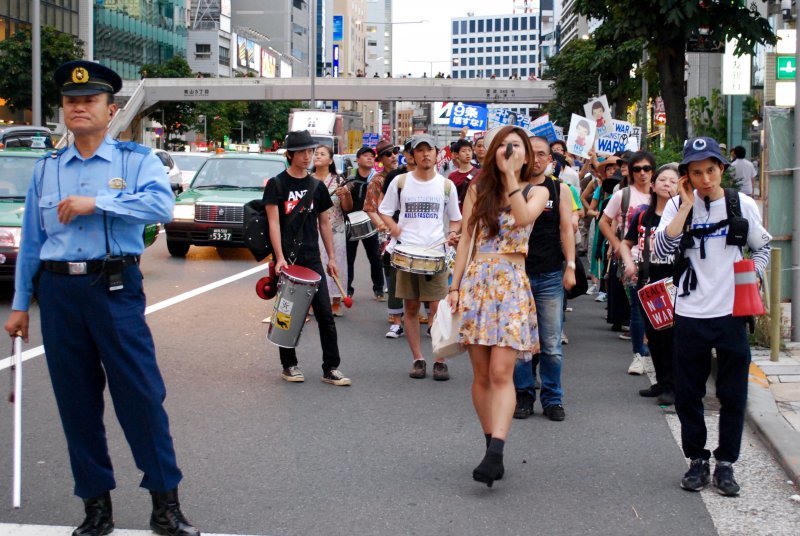

We need to attract regular university students who would otherwise be uninterested in social movements. Until now, it was fine to have social movements only amongst those activists, but now we are in the situation where we need to get people who would not be interested in or care about social issues. I think there are many reasons why previous social movements have failed and disappeared, but I think their way of doing things is just old; not to mention they look uncool…So we needed to refresh the image itself in order to attract regular university students who grew up with new things and are not interested in social issues.
Protest Posters at the SEALDs demonstration, August 23, 2015, Shibuya
Sometimes we are criticized because of the fact that we are all university students, but that’s who SEALDs are. We are people who can go to university: who can receive the opportunity to get an education even if we have to borrow money from scholarship programs. I don’t know if we call it the environment we grew up in, but we are from a certain social class so we are not like those contract (haken) workers who are having a hard time making ends meet and lashing out in anger toward the establishment.
Our actions are backed up with our education, so I think that’s why our movement has become successful and that is a big difference. People sometimes criticize us saying that we are the social class that has not committed to any social movement, and that we should just do something else if we have freedom (yoyu). But we are just different from those types of people who have participated in the old movements—we do have freedom, and we do have an education.
Our movement is not our life; it is a part of our life not our whole life. I went to class yesterday as usual, and we have rappers, people who do music, people who just study, people who are trying to be teachers, we have all kinds of people, and our movement is a part of what we do in our life but not our whole life. If you focus on the movement and movement only, you will become narrow.
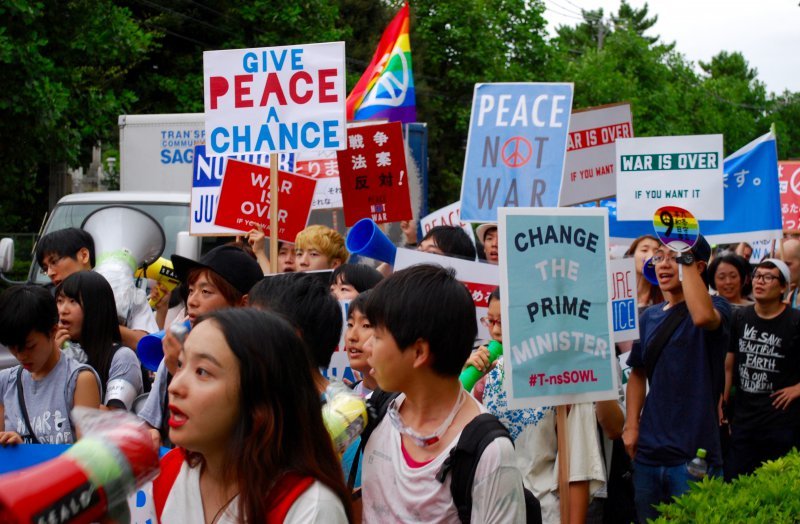
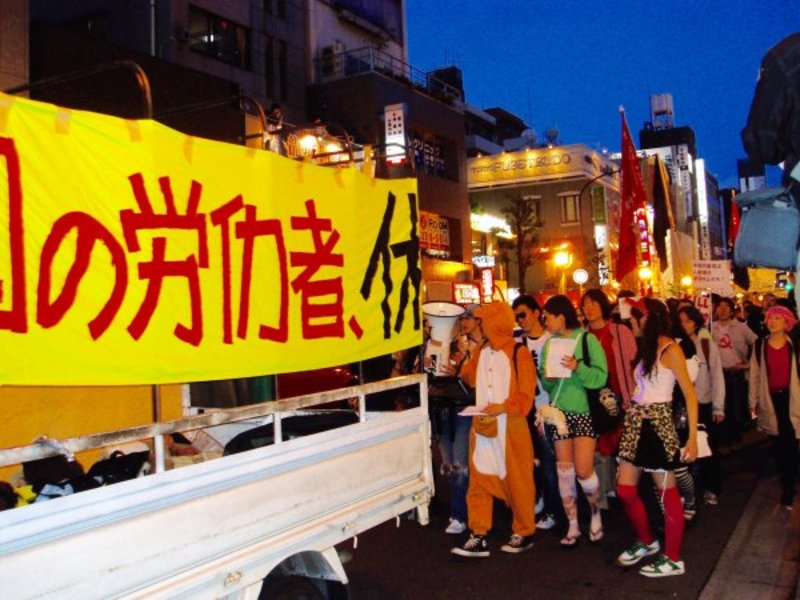
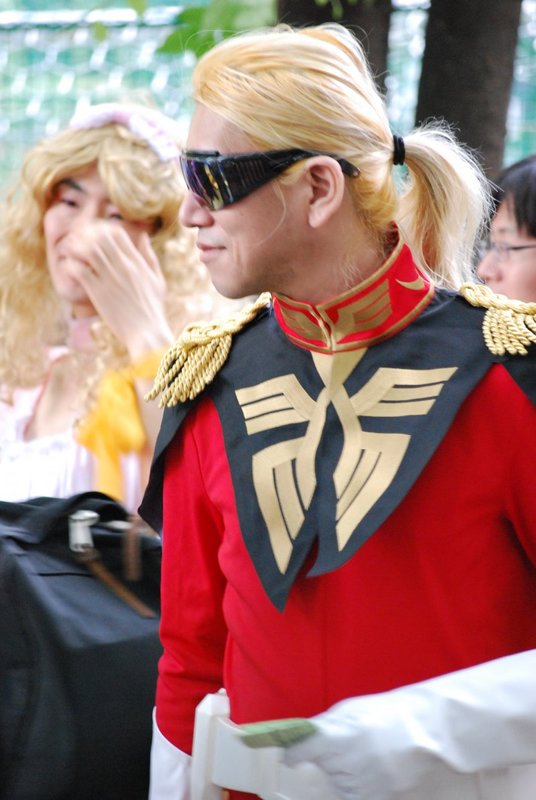
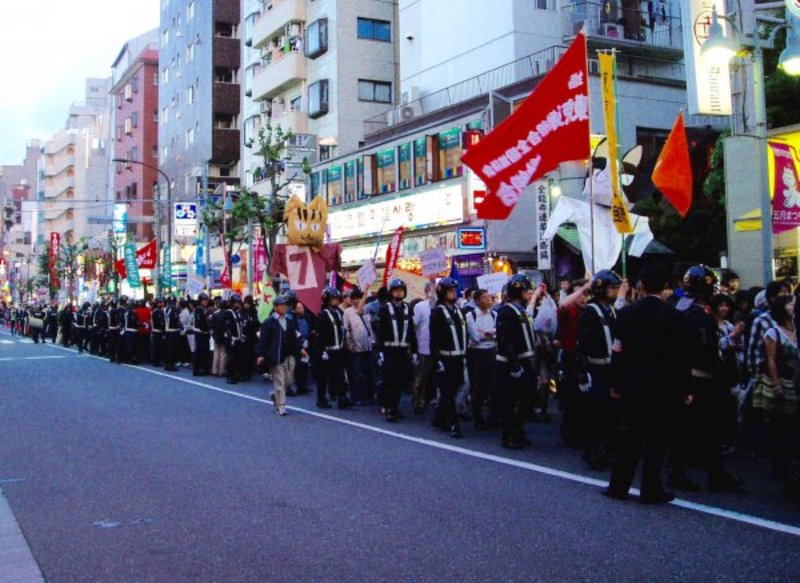
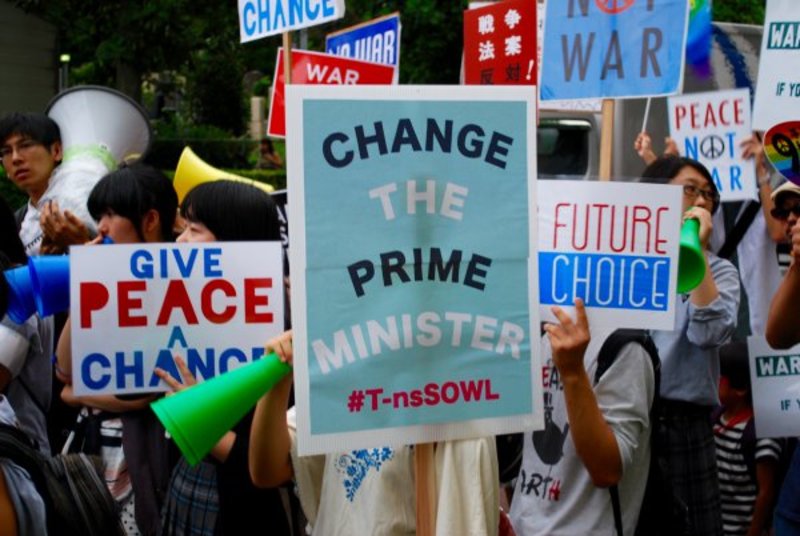
Leave a Reply
You must be logged in to post a comment.